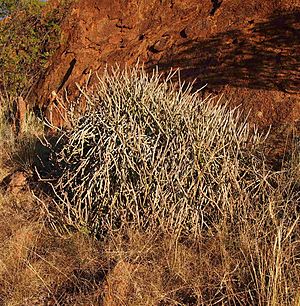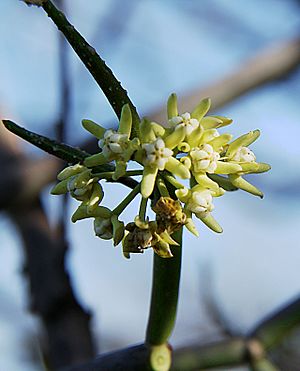Cynanchum viminale facts for kids
Quick facts for kids Cynanchum viminale |
|
|---|---|
 |
|
 |
|
| Scientific classification | |
| Genus: |
Cynanchum
|
| Species: |
viminale
|
| Synonyms | |
Cynanchum viminale is a unique plant that doesn't have leaves. It's a type of succulent, which means it stores water in its stems. This plant belongs to the Apocynaceae family.
You can find Cynanchum viminale in many parts of the world. It grows naturally across Africa, the Middle East, India, and Southeast Asia. It also lives on islands in the Indian Ocean, like Mauritius and the Seychelles.
People know this plant by many different common names. Some of these names include caustic-creeper, caustic bush, sacred soma, and Rapunzel plant.
Cynanchum viminale has green, round stems that do the job of leaves by making food from sunlight. It can grow as a small bush or as a climbing vine. If you break a stem, a lot of milky liquid comes out. This liquid is called sap, and it can be irritating or cause burns if it touches your skin.
The plant produces small white flowers that grow in groups. After the flowers, long seed pods appear. These pods hold many seeds, each with silky plumes. These plumes help the seeds fly away in the wind. This plant can grow in many different places, from wet rainforest edges to dry deserts.
Traditional Uses of Cynanchum viminale
For a long time, people have used Cynanchum viminale in traditional medicine. They used it to help with many health problems. These include treating cuts and sores, eye infections, and stomach issues. It was also used to help mothers produce more milk.
People used different parts of the plant, like the stems, roots, and the milky sap. They had various ways of using it. Sometimes they would eat parts of the plant. Other times, they would drink a tea made from it. The sap might be put directly on affected areas. People also used smoke from burning the plant or rested on bedding made from it.
It's important to be careful when using this plant. The sap can be irritating or even harmful. However, in some places, people believe it's not very harmful, at least at certain times of the year.
Plant Safety and Animals
The plant's safety can change from one place to another. Cynanchum viminale is known to make farm animals sick, and it can even cause death. But in Kenya, some people think it's good food for animals. In Somalia and South Africa, people sometimes eat the stems. They might eat them raw or cooked.
Understanding the Plant's Name
The scientific name of this plant has been a bit confusing for scientists.
Scientists used to call this plant Sarcostemma viminale. But in 2002, new research showed that the group of plants called Sarcostemma actually fits inside another group called Cynanchum. So, the correct scientific name for the plant is now Cynanchum viminale.
Even with this change, some scientists still use the old name, Sarcostemma. This is despite more recent genetic evidence that supports the new name.
This plant also has many different types within its species, called subspecies. It can be hard to tell exactly how many there are. It's also tricky to tell C. viminale apart from other plants that are very similar to it.
- Sarcostemma viminale in West African plants – A Photo Guide.

